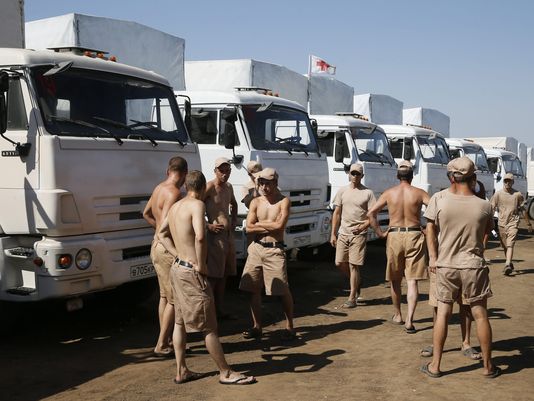
The Russian defense ministry flatly denied the report and the Russian Foreign Ministry said it has information that Ukraine was planning to attack the now stalled 262-truck Russian humanitarian convoy.
Ukrainian president Petro Poroshenko confirmed the attack on the Russian armored personnel carriers in a telephone call, saying that a "significant" part of the military column had been destroyed, according to the Ukrainian leader's website. "Much of this equipment was destroyed by the Ukrainian artillery at night," the statement says.
Andriy Lysenko, spokesman for Ukraine's National Security Defense Council, also reported that parts of the armored were "destroyed."
Comment: We guess that explains why there most likely will be no credible evidence brought forward: it was 'destroyed'!
"Appropriate actions were undertaken and a part of it no longer exist," Lysenko told reporters. He said the military convoy had been closely observed since crossing the border from Russia.
Comment: So where's the rest of it? Evidence, please.
Ukrainian Defense Ministry spokesman Leonid Matyukhin told Bloomberg News that the vehicles had been painted white to camouflage the operation as a peacekeeping mission.
A reporter for The Guardian said he saw a column of 23 armored personnel carriers, supported by fuel trucks and other logistics vehicles with official Russian military plates, crossing into Ukraine "through a gap in a barbed wire fence that demarcates the border."
Comment: Did he take any photos?
NATO leader Anders Fogh Rasmussen said earlier Friday that "a Russian incursion" over the Ukrainian border had been observed during the night. "It is a clear demonstration of continued Russian involvement in the destabilization of eastern Ukraine," Rasmussen said at a news conference in Denmark.
Comment: What about the U.S.'s admitted, documented, and continued destabilization of the region?
The British foreign office summoned Russian Ambassador Alexander Yakovenko "to clarify reports of Russian military incursion," the BBC reported.
The Russian defense ministry said such reports were false. "No Russian military column that allegedly crossed the Russian-Ukrainian border at night or during the day ever existed," said Major General Igor Konashenkov, a spokesman for the Russian Defense Ministry, RT.com reports.
Russia's Security Service, which oversees border guards, said its military mobile teams operate "strictly within the territory of the Russian Federation," a spokesperson for the FSB in the Rostov region told RT.com.
Russia's foreign ministry, meanwhile, said only that Ukrainian forces are engaging in "intense fighting" in Eastern Ukraine to stop humanitarian aid to the region and charged that the Ukrainians were planning to mine the roads ahead of the Russian humanitarian convoy, according to RT.com.
Ukraine had insisted that the Russian relief goods -- food, generators and medical supplies -- be inspected and reloaded before being allowed to proceed to hard-hit areas of eastern Ukraine, particularly the besieged city of Luhansk.
For several days, as the trucks wound their way from Moscow, Ukrainian officials expressed concern that the trucks might contain military equipment as a cover for a military invasion.
The BBC reports that many the trucks in the aid convoy were almost empty. It quoted one driver as saying those trucks were to be used to pick up the cargo from any trucks that might break down on the journey.
Ukrainian officials initially said the inspection was underway, but said later that it had been delayed until customs officials received relevant paperwork from the International Committee of the Red Cross, which will distribute the goods, according to Interfax Ukraine.
The U.S. State Department also weighed in, saying that the U.S. had warned Russia that it "has no right to send vehicles or persons or cargo of any kind into Ukraine without the government's explicit permission," according to U.S. State Department spokeswoman Marie Harf.
Comment: You tell 'em, Harf! No one's allowed to help out an oppressed people without their oppressive, illegitimate government's explicit permission!
Under the deal finalized Friday morning, 41 Ukrainian border guards and 18 customs officials were tasked with inspecting the trucks, Ukrinform reports. Only one driver per truck, not a full crew, was being permitted to take the goods into Ukraine.
In line with Red Cross policy, there will be no military escort. The Red Cross will also exclusively carry out the final distribution of the goods.
The Russian white-tarped trucks had been parked since Thursday near Kamensk-Shakhtinsky, about 17 miles from the border. Much of the border in this part of eastern Ukraine has been under the control of the pro-Russia separatists
Russia sent the convoy south to the rebel-held crossing after deciding not to abide by an earlier tentative agreement to deliver the aid through a government-controlled border crossing in the Kharkiv region.
Laurent Corbaz, the International Committee of the Red Cross' director of operations in Europe, said the plan foresees the aid being delivered to a central point in rebel-held territory, then distributed through the region. It was unclear how long the operation might last, but "it's not going to be solved in one week," he said.
The humanitarian crisis emerged during four months of fighting in eastern Ukraine between Ukrainian troops and rebels, who had declared the region independent. Government forces in the past two weeks have surrounded the key rebel strongholds of Donetsk and Luhansk, which has been without water or electricity for three weeks.
The United Nation's nearly doubled its estimate for the number of people killed in eastern Ukraine to 2,086 as of Aug. 10 from 1,129 on July 26.



Comment: It's looking like Kiev will do just about anything to prevent people from seeing Russia for what it truly is in this 'conflict': the only one who really cares, who really wants peace, and who is actually doing anything to help and support the suffering civilians caught in the crossfire.